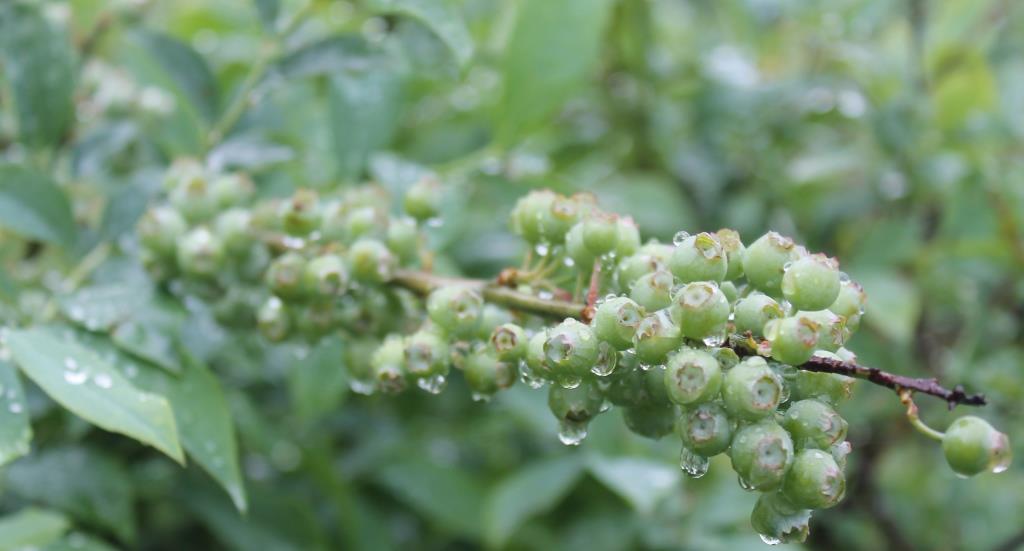
by Matthew Orwat | May 6, 2014
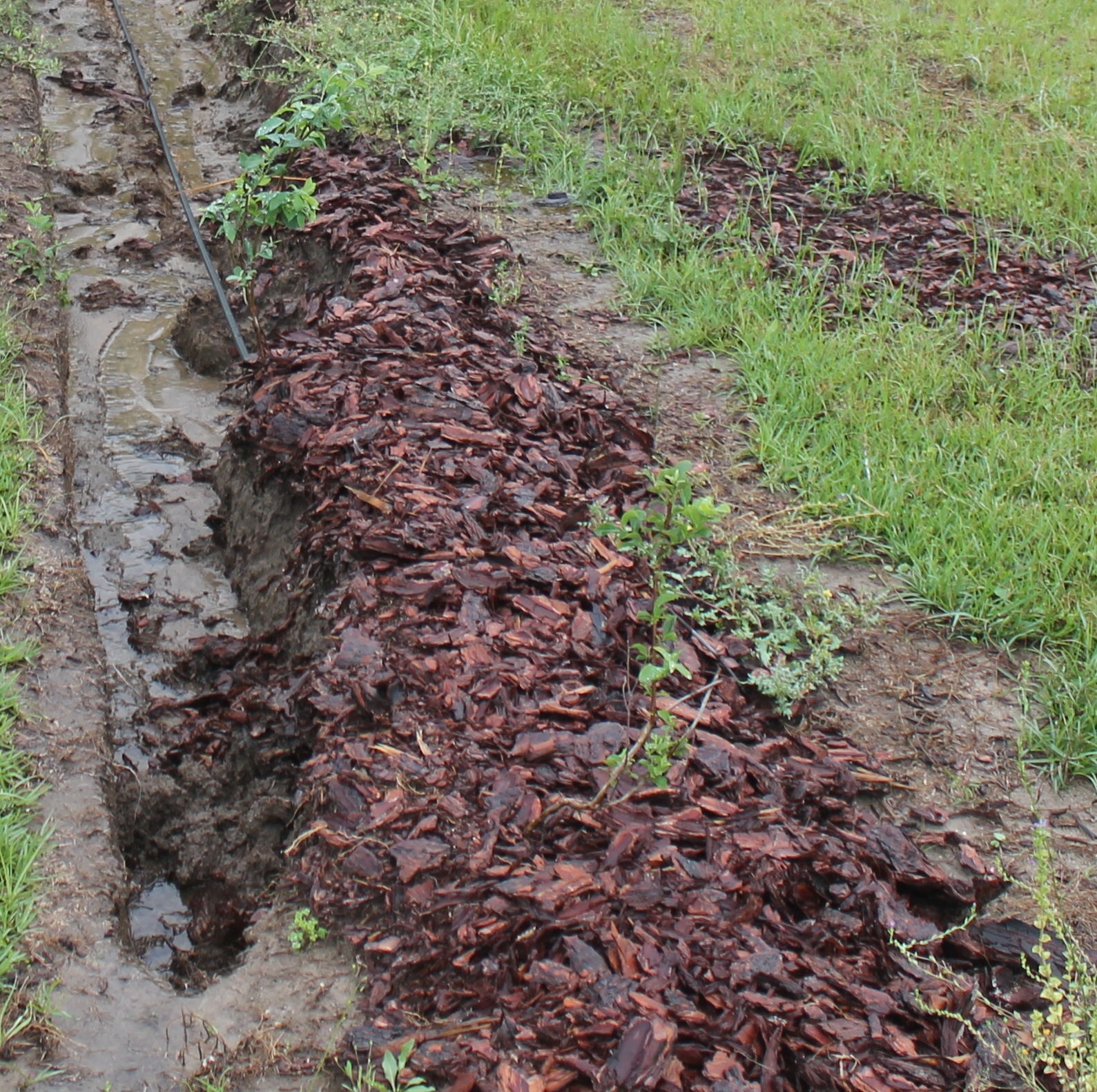
Wash-out in blueberry field, young planting. Image Credit Matthew Orwat
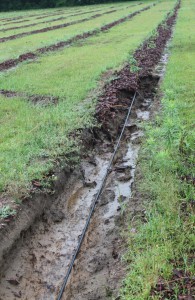
Washed out row in young blueberry field. Image Credit: Matthew Orwat
Although the central Florida panhandle has been hit with excessive rainfall this spring, the blueberry yield this year is on track to be above average. Colder winter temperatures coupled with wet spring weather has enhanced the yield potential of properly tended and well established planted blueberries. If you have a few established blueberry plants in your home orchard, the outlook looks bright. If you do not, don’t fret. There are plenty of U-Pick operations and local farmers market vendors that will have berries available June through July, at great prices!
Blueberries do best planted in low pH soil on slightly sloping ground. This prevents the collection of water and resulting root rot in areas with poor drainage. While this situation is ideal for established blueberry plants, this slightly sloping situation can cause issues for newly planted blueberries. Field wash-outs caused by excessive rainfall can wreck newly planted rows, because the pine bark added to the planting trench is less dense than soil.
After all this rain, what should the home gardener do to ensure a productive harvest this summer? Addition of fertilizer will help. Although blueberries usually require low fertilization rates, if leaves show yellowed edges, red spots or general yellowing, fertilizer may have leached out. Application of a few ounces of ammonium or urea based fertilizer around the root zone (24 inch) of established plants may be beneficial. It is a good idea to look for “Blueberry Special” blends or “Camellia & Azalea” fertilizer. To learn more about blueberry fertilization, consult the Blueberry Gardener’s Guide.
A drier May will help blueberries produce their greatest sweetness as they develop. Late May and June rains could cause fruit split, so less rain during this period is desired!

Blueberries developing for harvest, a month away. Image Credit Matthew Orwat
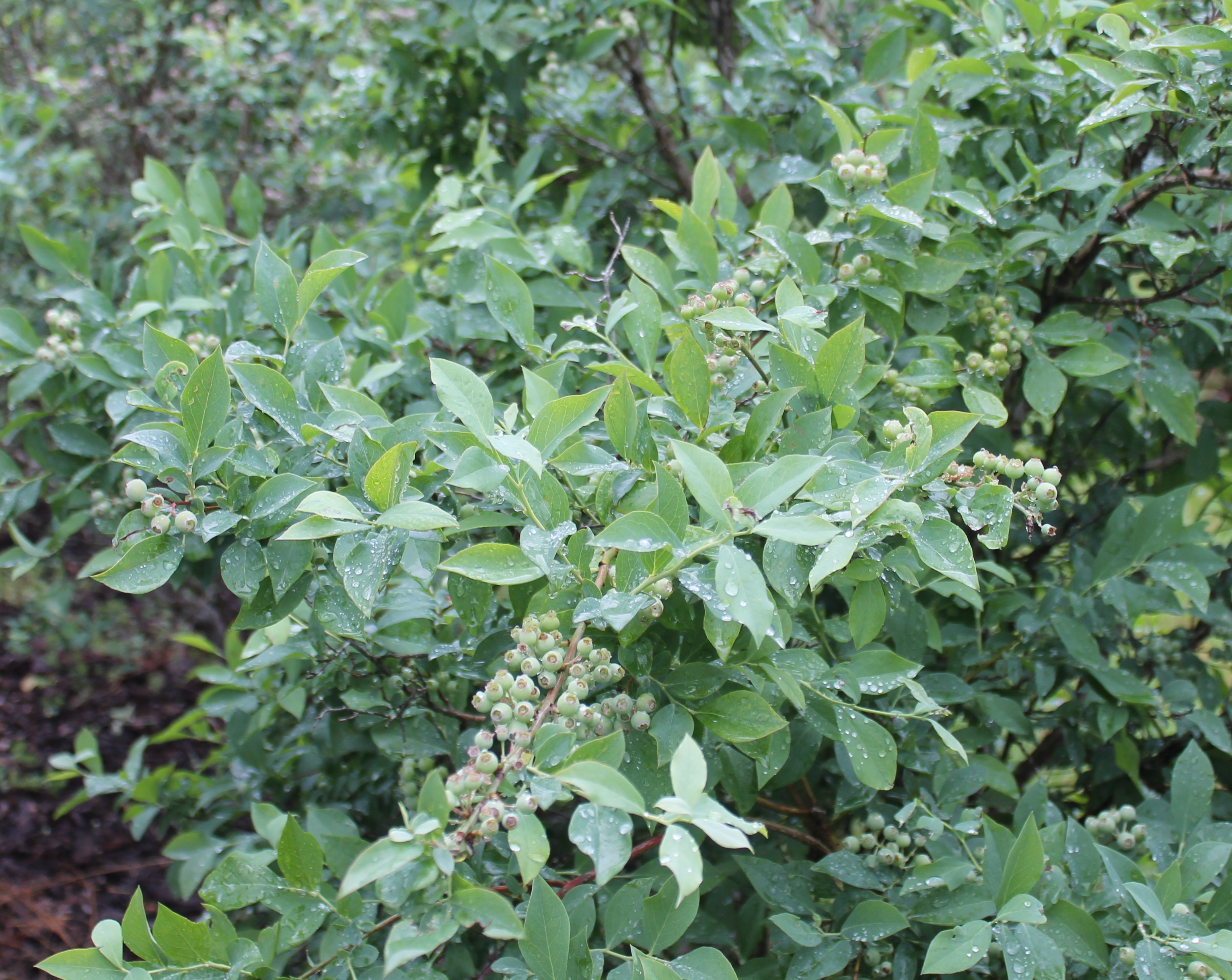
Blueberry bush, full of developing fruit. Image Credit Matthew Orwat
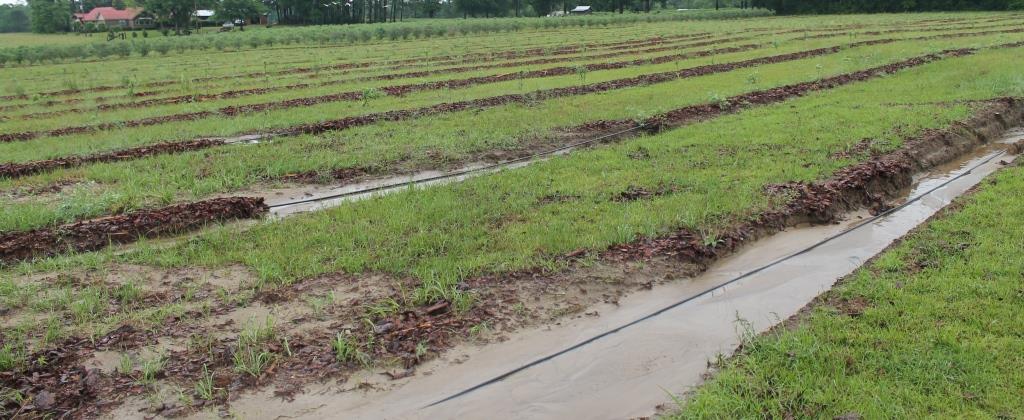
Washed out rows of young blueberries. Note healthy established plants in the background. No washout due to established root system. Image Credit Matthew Orwat

Emergency drainage ditch dug to reduce wash-out damage from field runoff. Image Credit Matthew Orwat
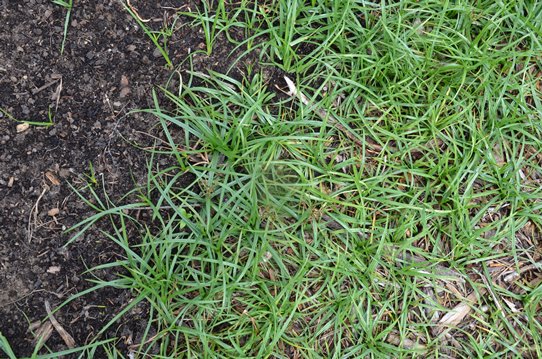
by Les Harrison | May 6, 2014

Purple Nut Sedge aggressively moves into any sunny open space and crowds out competitors.
The spring season in panhandle Florida is colorful. Every location from frequently manicured gardens to untended fields and pastures are exploding with hues and tones pleasing to the eye.
These heralds of the warmer weather to come are trailed by the warm season’s greenery which fills in the gaps between blooms. The consistent and ample rains have assured the continuance of a bright and pleasing landscape backed by countless shades and textures of green.
The adequate moisture has also assured the aggressive growth of an individually small, but collectively gigantic, weed which plagues every member of humanity associated with attempting to cultivate plants.
Purple nut sedge, Cyprus rotundus, has emerged en mass from every possible sunny location with soil. This native plant is a rapidly spreading perennial which will take every opportunity to colonize new locations.
The identifier purple is in the name because there is a purple-tinged section of this sedge where it emerges from the ground. The plant is sometimes referred to as purple nut grass because of its long narrow leaves and its erect growth pattern originate from a nutlike basal bulb.
There are other sedges in north Florida, but only yellow nut sedge is identified by a specific color. It is sometimes called chufa and is a popular feed for wild turkeys and turkey hunters.
The dark green, smooth leaves blend in easily with many turf grasses. Beneath the soil’s surface and out of sight, the root system grows in every direction.
Purple nut sedge’s roots are a series of spreading rhizomes and tubers or bulbs identified as nutlets. Each nutlet sprouts a new bunch of grass-like leaves and continues growing the rhizomes.
The densely population of this sedge quickly crowds out most other plants, but most especially turf and forage grasses. It can reach a height of 18 inches on its triangle shaped stem.
The root system’s design assures this plants survival and continued success. If pulled, the rhizomes break off leaving a large number of nutlets to develop and emerge at a later date.
If plowed or tilled, the nutlets are detached and spread to new and inviting locations. Many times nutlets lodge in tillage equipment only to shake loose and deposited in un-colonized locations.
Most herbicides have little on this sedge’s hardy root system. Selected pre-emergent herbicides will prevent many of the nutlets from germinating in spring.
North Florida’s sandier soils provide an ideal growing environment for purple nut sedge. The occasional periods of water saturation from storms do not deter this plant’s rapid and growth expansion to new areas, but it will not tolerate heavy shade.
Purple nut sedge’s extreme competitive nature is a heavy consumer of plant nutrients and robs rivals of important compounds necessary for their survival. Additionally, it produces an allelopathic substance which is toxic to some plants.
Purple nut sedge is found in many locales in North America where the environment is hospitable to its growth. The lush green leaves and touch of purple signify work for anyone who is maintaining a lawn or garden.
To learn more about purple nut sedge in north Florida contact your local UF/IFAS County Extension Office and read this informative publication on purple nutsedge.
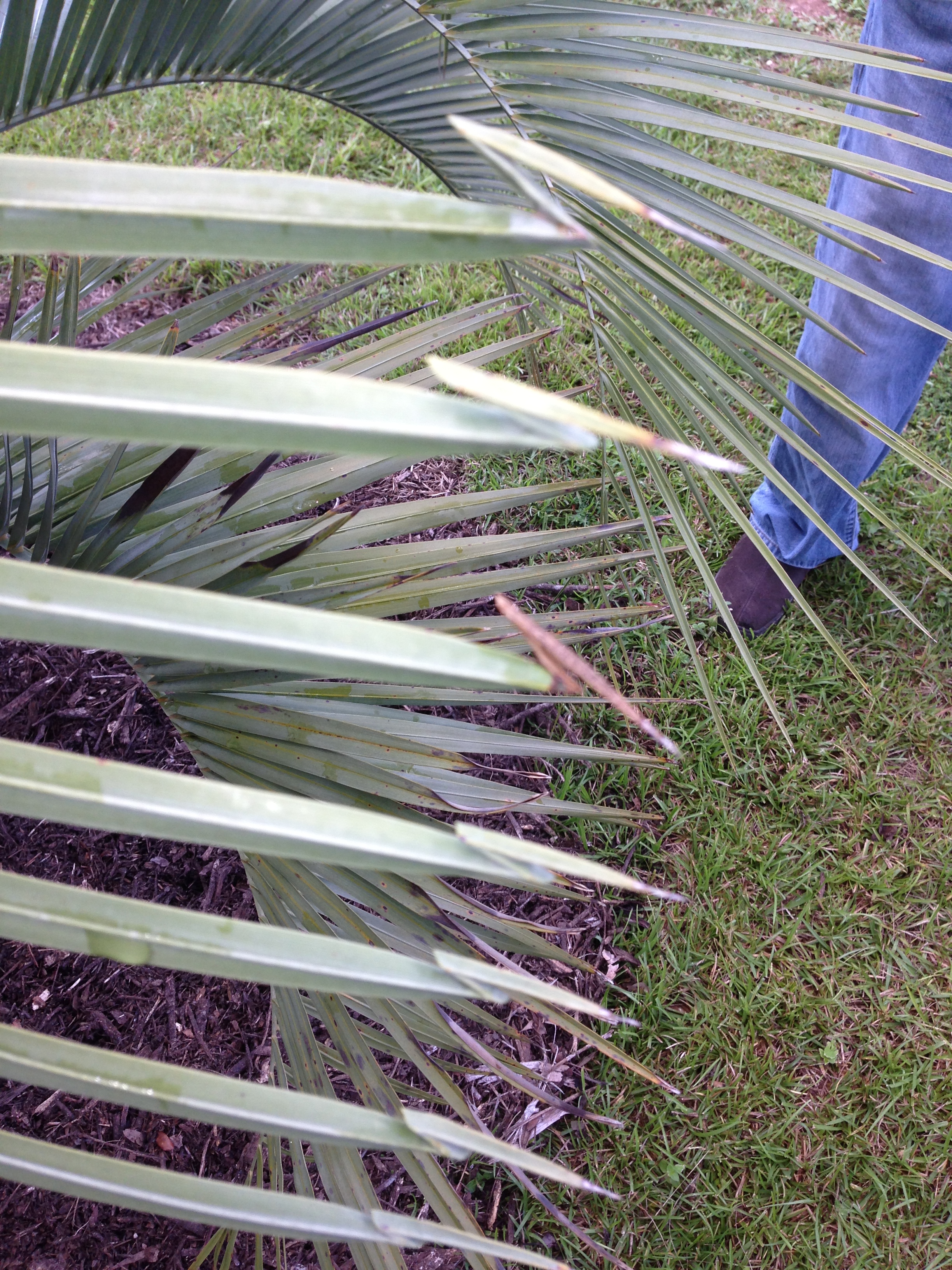
by Blake Thaxton | May 6, 2014
Palms can be difficult to manage in Northwest Florida. To have healthy palms it is important to think about possible cold temperatures, disease, and nutrient needs of palms. The panhandle of Florida was blasted with cold this winter and it is easy to see the effects on the palms. There are many palms throughout Northwest Florida which appear or are dead. This article will give information on several of the pesky palm problems observed throughout the region and some recommendations to help!
Cold damage is evident right now from this past winters’ very harsh temperatures. Some recommendations to help alleviate this problem include selection of the proper species. Some palms are not suited for colder temperatures and this must be taken in to account or you will continue to have problems even during mild winters. Look at the publication that has a table of palm suited for north Florida: Palms for North Florida
Next, develop a plan of action if your palm has been effected by cold damage. As has been seen throughout the panhandle, freeze damage can make an entire palm canopy turn brown and desiccate (dry out). It can even go as far as killing the spear leaf (The newly emerging palm leaf that resembles a spear). Even if the spear leaf has died and easily pulls out of the canopy, the palm may not be dead. If the meristem (the area of replicating cells that new leaves emerge from) survives the palm will also survive. If the spear leaf does die, give the palm 5-6 months to send out a new leaf before declaring it dead.
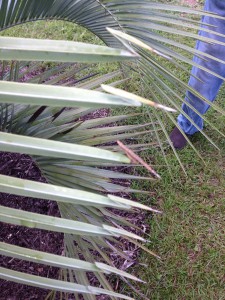
Hook-Leaf caused by an acute Boron deficiency
Another issue that may arise in the near future with the recent heavy rains is Boron deficiency of palms. Boron deficiency can be cause by leaching of soil Boron out of the root zone by heavy rain falls or heavy irrigation. When Boron has been leached from the soil it causes an acute (temporary) deficiency that will only last until microorganisms have time to break down more soil organic material that releases more Boron to the palm. Symptoms include small and crumpled new leaves, angular leaf tips, “hook-leaf”, and sometimes the stem bends sharply to one side. The symptoms won’t be visible for 4 to 5 months as the deficiency affects the leaf during development prior to its emergence. By the time it is seen the problem has probably already been corrected.
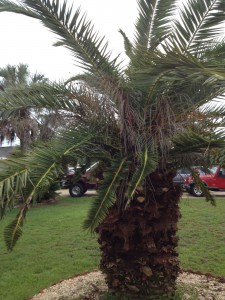
Chronic Boron Deficiency
Also, chronic (long-lasting) Boron deficiency problems can occur on palms. This deficiency is usually caused by soil drying and high soil pH. If there is a chronic Boron deficiency a drench can be applied to correct the problem. Learn more about Boron Deficiency of Palms
by Julie McConnell | May 3, 2014
The last week of April 2014 brought with it 10-22 inches of rain across the panhandle in a matter of days. Some areas had immediate flooding and standing water, while others may be in areas at risk of rising rivers and streams. As the water recedes, many people are wondering how all the water will affect their landscapes.
Only time will tell what the long term impact will be, but here are a few things to watch for and what you can do to try to moderate damage.
- Let soils dry out before driving vehicles or other equipment on grassy areas. Even if the water is not visible, if the soil is still saturated, driving lawn equipment or cars may cause ruts.
- Do not leave automatic irrigation systems running on established shrubs, trees, and lawns. If your system is set to run in the early morning hours, you may not think about it being on, check your systems and hold off on adding water until soils dry out and the plants need it.
- Watch for fungus symptoms and treat if needed. Wet plants and cool weather are ideal for some Brown Patch on lawns, be aware and monitor landscapes closely. If disease is suspected, contact your local county extension office for recommendation.
- When mowing, leave a longer leaf blade to compensate for root stress.
- Look at the base of trees and shrubs to make sure silt and sand have not buried the crown or root flare. Also look for erosion of root zone, these areas may need correction. “Salvaging Flood-Damaged Shrubs and Ornamentals.”
- Adjust fertilization as needed; if you recently applied fertilizer it has likely runoff or leached from the site. However, if you suspect fungal disease do not fertilize until disease is managed.
- Stress in turfgrass, for details read “Watch Turf for Flooding Stress”
- You may see new weeds (seeds or segments may have washed or blown into your yard)
- Tree and shrub decline or death read “We Had Plenty of Rain, Why are My Trees Dying?”
- Although this storm was not a hurricane, “Assessing Damage and Restoring Trees After a Hurricane” has helpful information for areas with wind damage
- Nutritional deficiency symptoms in palms may show up 4-5 months from now. “Nutrient Deficiencies of Landscape and Field-grown Palms in Florida.”
- Decreased availability and increased price of sod (flooded fields prevent harvest and increase inputs for disease, weed, and nutrition management)
- Scheduling changes or maintenance adjustments by landscape contractors. Turfgrass and ornamentals will likely need different maintenance applications than in years past to correct issues related to flooding and excess rain.










